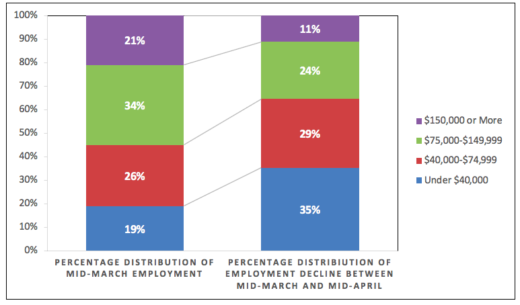 Our recent NEJHE piece revealed that labor market impacts of COVID-19 shutdowns have been very unequal across industries, occupations and levels of educational attainment. Job losses in the month since the beginning of the shutdowns (between mid-March and mid-April) were concentrated in industries that primarily employ individuals with lower levels of education—industries such as leisure and hospitality, retail trade, construction, manufacturing, and personal services.
Our recent NEJHE piece revealed that labor market impacts of COVID-19 shutdowns have been very unequal across industries, occupations and levels of educational attainment. Job losses in the month since the beginning of the shutdowns (between mid-March and mid-April) were concentrated in industries that primarily employ individuals with lower levels of education—industries such as leisure and hospitality, retail trade, construction, manufacturing, and personal services.
Eight of 10 jobs that were lost between mid-March and mid-April occurred in these industries characterized by below-average skill requirements and weekly wages. This means that individuals with lower levels of education have borne a disproportionate share of the costs of the shutdowns.
Indeed, the April 2020 unemployment rate of adults without a high school diploma was over 21%; 2.5 times higher than the 8.3% unemployment rate among their counterparts with a bachelor’s or higher college degree. The COVID-19 shutdowns have also had outsized impacts on youth. Over the mid-March to mid-April period, employment fell by 31% among teens (16-19) and 25% among young adults between 20- and 24-years-old, compared with 13% among those 25 and older.
These disproportionate effects of the COVID-19 shutdowns have led to massively unequal adverse impacts by level of household income. Although workers across the household income distribution all suffered some degree of job losses and reduced hours of work as well as cuts in compensation, the greatest employment declines occurred among workers at the bottom of the household income distribution.
In the month between mid-March and mid-April, employment among workers with household incomes below $40,000 fell by 7.6 million, representing one-quarter of their pre-shutdown employment in mid-March (Table 1). About one-third of U.S. households have incomes below $40,000. The U.S. median household income is $63,000, meaning that one-half of households have incomes above this level and the remaining half below.
Employment losses among workers with household incomes between $40,000 and $75,000 were also sizeable, albeit not as large as those among their counterparts with lower household incomes. This group of workers saw an employment decline of 6.3 million or 16% of their pre-shutdown employment level (Table 1). One-quarter of U.S. households have incomes in the $40,000 to $75,000 range.
Higher income groups were much less affected by job losses from the COVID-19 shutdowns. Employment losses in the remaining two income groups were 5.3 million or 10% among workers with household incomes between $75,000 and $150,000 and 2.5 million or 8% among those with household incomes of $150,000 or more (Table 1). About one-quarter of U.S. households have incomes between $75,000 and $150,000 and 15% have annual incomes of $150,000 or more.
Table 1:
Change in U.S. Employment by Household Income of Workers, Mid-March 2020 to Mid-April 2020
| Household Income Levels | Mid-March 2020 | Mid-April 2020 | Absolute Change | Relative Change |
| Under $40,000 | 29,991,076 | 22,373,122 | -7,617,954 | -25% |
| $40,000 -$74,999 | 40,615,166 | 34,302,827 | -6,312,339 | -16% |
| $75,000-$149,999 | 52,683,946 | 47,405,305 | -5,278,641 | -10% |
| $150,000 or more | 31,990,681 | 29,509,003 | -2,481,678 | -8% |
| Total | 155,280,869 | 133,590,257 | -21,690,612 | -14% |
The disproportionate nature of job losses by income is evident in the comparison of the shares of employment levels in mid-March and total loss of employment in the following month by household incomes. Workers at the top of the income distribution (household incomes of $150,000 or more) accounted for a little over one-fifth (21%) of mid-March employment, but just over one-tenth (11%) of employment losses between mid-March and mid-April. Low-income workers also comprised about one-fifth (19%) of the total employment in mid-March, but they sustained more than one-third (35%) of the over-the-month employment decline.
Chart 1:
A Comparison of the Percentage Distribution of Mid-March Employment Levels and Decline in Employment between Mid-March 2020 and Mid-April 2020 in the U.S.

Over just a few weeks, the COVID-19 shutdowns have imposed unprecedented economic and social costs on Americans from widespread job losses and economic devastation. Exacerbating these problems is the inequality in the burden of these costs that are disproportionately borne by individuals from low-income families, youth, and less-educated workers. These shutdowns have further reduced living standards among those who were already at the bottom of the economic strata; crushing the livelihoods of those among us who are most in need of jobs and incomes. The plight of these workers must be recognized and considered in all shutdown decisions.
Neeta Fogg is research professor at the Center for Labor Markets and Policy at Drexel University. Paul Harrington is director of the center.
[ssba]
